
This is for me an English ferment, and I have fond memories of fish and chips on a Saturday night, with a side of Piccalilli, at my grandparents’ house in Birmingham, England, when I spent a few months there with them in the 1980s. But while many national fermented foods have a long history, this pickle probably originated in India and was brought back from there in the mid-eighteenth century. It is also called the Indian Pickle and Chow Chow. For me, it has always been Piccalilli.
The key to the flavour for me is that wonderful blend of sweet and sour you get from the two-step process. In the first step, you ferment your vegetables, making this pickle super healthy and good for your gut. In the second step, you drain the fermented vegetables and then add malt vinegar and honey for a powerful, rich flavour that was meant to be eaten with fish and chips, preferably at an English pub. Here is the recipe:
Equipment:
- Sharpe knives and a cutting board
- A large fermenting jar or fermentation pail
Ingredients:
- One medium head of cabbage
- Three cups of finely diced seasonal vegetables (Cauliflower, carrots, broccoli, green beans, zucchini, capsicum)
- One red onion
- Two teaspoons of yellow mustard seed
- One teaspoon of ground cumin
- Two to three tsp salt (non-iodised)
- Two tablespoons freshly grated turmeric root (or one tablespoon turmeric powder)
- One tablespoon of diced red chilli (optional)
- One to two cups of non-chlorinated water (enough to completely cover the vegetables
- Probiotic Vegetable Fermentation Starter (optional)
After Fermentation
- 1/4 cup of honey
- 1/4 cup of live malt or beer vinegar
Instructions:
- Finely chop all of the vegetables.
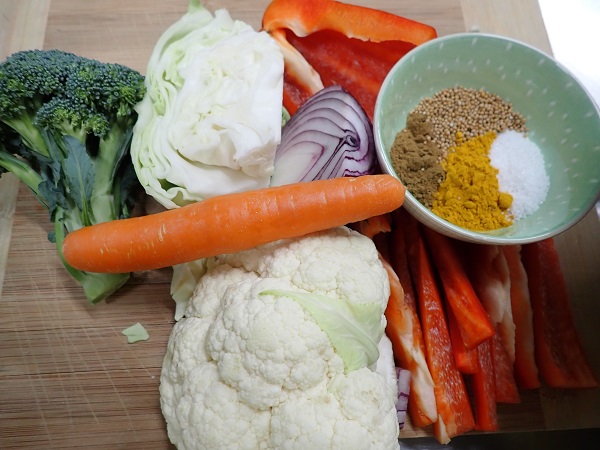
- Mix vegetables with salt and spices in a big bowl.
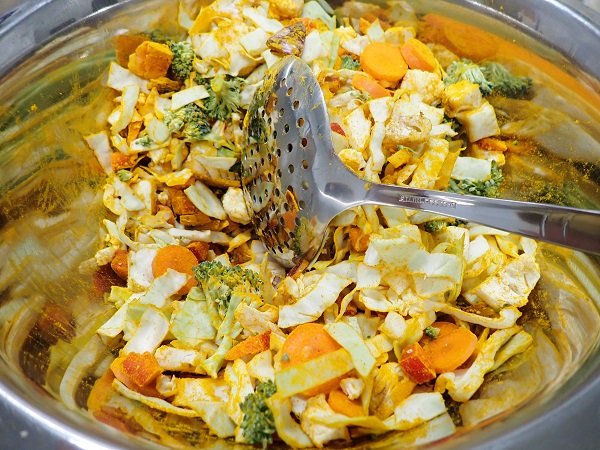
- Pack the vegetables into your fermentation pail, leaving enough space to insert the grate. If you are using a large jar, you will need to save a few cabbage leaves to put on top of your ferment to hold the vegetables underneath the fermenting liquid.
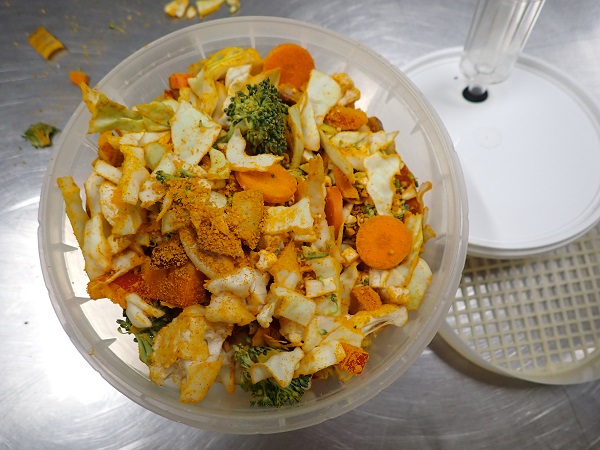
- Mix your Probiotic Vegetable Fermentation Starter with one cup of non-chlorinated water. (Optional)
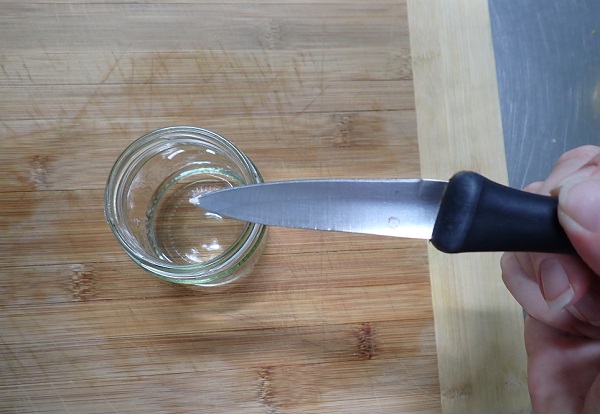
- Pour the cultured water over the vegetables. Pack the vegetables down so they are below the liquid, and top up with more non-chlorinated water as needed.
- Top the vegetables with either the grate or the cabbage leaves to keep them below the liquid. Let them ferment in a cool, dark place for 3 to 5 days. It will take longer without the culture added. The pantry is perfect. If you are using a jar without an airlock, burp daily so that the pressure does not build up and explode the jar.
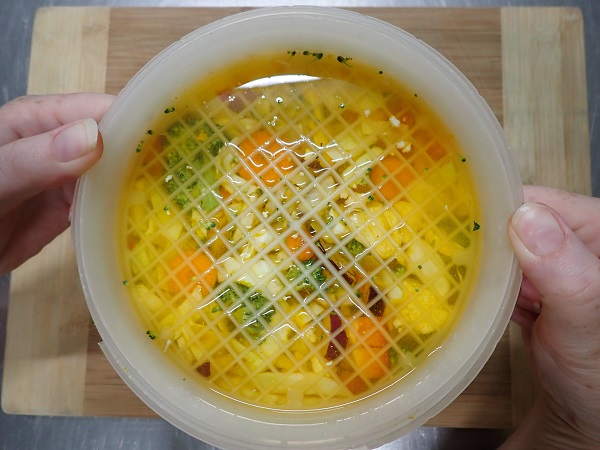
- After the fermentation stage, the vegetables should have an acidic taste. The longer you leave it, the stronger this flavour will be. When you are happy with the flavour, drain the excess liquid from the vegetables. You can save this liquid to use as a starter for another batch or use it to make a salad dressing.
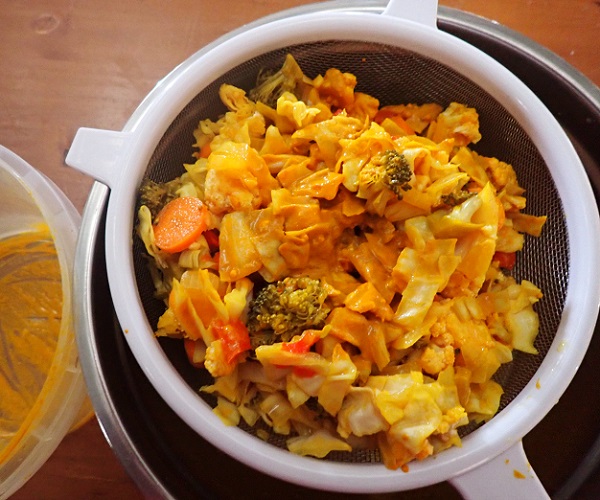
- Empty the fermented vegetables into a big mixing bowl. Mix in the honey and malt vinegar.
- Taste the piccalilli and add more honey and vinegar to taste.
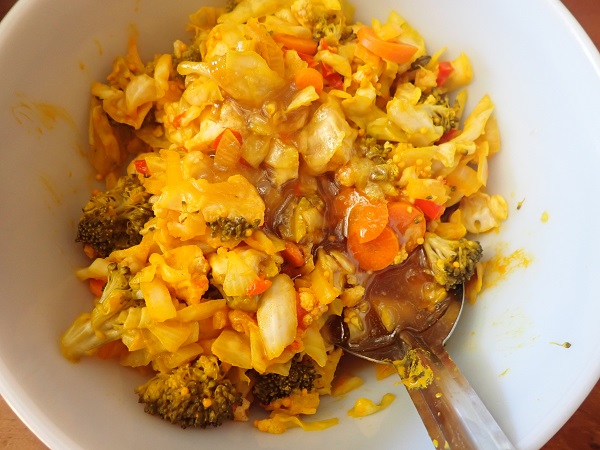
- Pack the Piccadilly into the jars and store them in the fridge, ready to eat.
I hope you enjoy this recipe as much as I do. It goes with so many things, but the quintessential English pub fish and chips and always a winner.
As always, live well.
hi there,
very new to this site & the fermentation process, but love your recipe & can’t wait to try it out.
Could you please explain how & where to i buy the product LIVE MALT OR BEER VINEGAR please?????????
I have never heard of either product as i said i am new to this way of preserving.
thank you & look forward to your reply
Trudy Dale
Hello Trudy and welcome:
Check out your local health food store. If they do not have it, they will have a live apple cider vinegar. I like the Braggs brand.
Valerie
your picalilli looks so scrummy! I know it as chow-chow. lucky me… I loved eating healthy even as a child with zero prodding. ps… almost emigrated to prosperpine/emerald about two lifetimes ago. life held me static on the border of mexico.
Emma,
I lived in Mexico for 6 months, many years ago. Small world. 🙂
Can you eat the picalili with the ferment liquid as is, without draining it and adding vinegar and honey? And can you use frozen vegetables? It is winter and the only capsicum from my garden are from last season and frozen.
Hello!
Yes, you can eat the Piccalilli without draining and adding the honey and vinegar, but it would not be the traditional way, and it may not be called Piccalilli anymore. In regard to using frozen vegetables, I have never tried this. Try just using available winter veg and leave out the summer veg that you can’t get right now. The recipe can be flexible to suite the season.
When you use the liquid from a batch to start another batch, do you need to add the probiotic vegetable fermentation srarter?
Hello Valerie,
No, you don’t. However; I try not to do this too many times as each time I do it, I drift a little further away from the original probiotics added, which are importanbt to my gut health. It’s called back sloping and it does work, up to a point.
Thank you so much for being so generous with the information you provide and your answers. Your website is great and found all the information I needed to make a start. I attended your presentation in Stanthorpe last week and gained a lot out of it. I started my first two batches of fermented vegetables yesterday and can’t wait to taste the result.
Just got my Deluxe Fermentation Kit – With Book and this will be my first crack. Fingers crossed. My go to up to know has been store bought sauerkraut with beetroot and apple which is awesome so looking forward to some variety. Great for my diverticulitis.
Hello John,
Enjoy the adventure. It is so muhc fun.
Valerie
Valerie, I was fortunate enough to find a Fermentation System (the pail with grate) at an Op shop yesterday and am keen to get started on fermenting veggies. I do make sauerkraut in a ceramic sauerkraut maker I bought from Aldi and it works fantastically with just Celtic Seasalt and the juice from the cabbage.
Now I want to start fermenting vegetables and I don’t mind if it takes awhile so am happy to not add the starter but I do have a few questions if you don’t mind?
1) Do the veggies have to be really, really fresh. I am a pensioner paying a high rent and I go to a food bank most weeks and get donated veggies so can I use these, mind you that is what I make my sauerkraut with and its perfect.
2) Years ago I when I was going to get into fermenting I purchased some Potassium Aluminum Sulfate Dodecabydrate because this is supposed to keep veges crisp (I had a disaster with baby cucumbers being soggy) but I never restarted my fermenting journey till now. Can I use this and is there a ratio I can work out per weight of veggies etc?
3) Does any vinegar work or does it have to be Malt, I have Apple Cider, White/Red Wine vinegars but not Malt.
4) What is the Calcium Chloride used for, I seen it for sale and is it the same as rennet or is it used in conjunction with rennet for cheese making and in yoghurt making only?
Hello Glynis,
I will answer your questions in order.
1. The older the vegetable the more likely your ferment will become contaminated. It will work, but older vegetable have a higher chance of having mould growth on them, even if you cannot see it yet.
2. I have never used Potassium Aluminum Sulfate Dodecabydrate. I have always used Calcium Chloride, which is the ingredient in Pickle Crisp, a product that is available in America.
3. Malt vinegar gives you a distinctive flavour. I suppose you could use apple cider vinegar, but it will change the flavour.
I hope this is helpful to you.